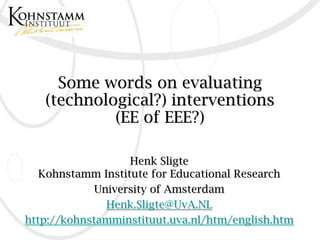
Ee eee
- 1. Some words on evaluating (technological?) interventions (EE of EEE?) Henk Sligte Kohnstamm Institute for Educational Research University of Amsterdam Henk.Sligte@UvA.NL http://kohnstamminstituut.uva.nl/htm/english.htm
- 2. Evaluation • Evidence based policy and practice: effect (impact) evaluation what works? • The other side of the medal: explanatory evaluation: what works for whom in what circumstances and why? Finer granulanity • Assignment of the Dutch Ministry of Education to develop a method to complement impact evaluation • Based on policy interventions, can it work for (technological) innovations, for EEE?
- 3. Effect (Impact) evaluation • Through (quasi)experiments demonstration of causal relation between intervention and found effects – Experiment: Controlled Randomized Trials – Quasi: natural experiment – Difference-in-difference: compare with business as usual (the whole population minus the experimental) Pretest-posttest model Compare with a similar control or reference groups Effects can exclusively be ascribed to intervention
- 4. BUT: • The rationale (the why) for these effects remains unknown: black box • Explanatory evaluation focuses specifically on this and can further validate the results of an impact assessment (effect evaluation) • Questions addressed: – How and why does an intervention work? – If there is no or a smaller effect occurs than expected, why is that the case? – Which unwanted / unintended effects occur (also unexpected positive)?
- 5. Intervention • VM2 – School drop-out in first year vocational education enormous – Intervention: combine systems of preparatory and normal vocational education – Effects: compare experimental group with population as a whole on numbers of dropouts – Conclusion: less dropout… “in xx percentpoint of the cases a significant lower chance of dropout”… – How do find more differential effects and how to understand them better?
- 6. Explanatory evaluation (EE) • Pawson, R. & Tilley, N. (1997). Realistic Evaluation. London: SAGE Publications • What works for whom in what circumstances and why? • Ex ante (before), ex durante (during), ex post (after) • Central to answering this question is the reconstruction of the policy (or program) theory • The policy theory is the sum of assumptions or hypotheses that explain how the policy should work These can be represented in statements like: • If (intervention) ... Then ... (Outcome), and in some cases also conditions But (take care that…)
- 7. EE: contexts • In the reconstruction of the theory, it is important to have an eye for the conditions and factors that play a role in a variety of contexts. • The context (or conditions) can be physical, but also social, for example, certain groups or characteristics of target groups (an intervention works only for motivated students). • Attention to circumstances helps explain why an intervention works better in one case than in the other case. • The intervention works through certain mechanisms, mechanisms that make "things work" and can be seen as the driving force behind an intervention.
- 8. EE • Creation of concrete causal schemes: Context-Mechanism-Outcome schemes – Problem mechanism – Intervention that generates Change Mechanism(s)
- 9. EE: field studies • Test the theory, test the hypotheses • Enter the field studies. The researcher must the different groups of actors in the picture. • Consider what information to whom can be achieved, what should be asked from whom: who knows what? • Formulate relevant questions for each (type of) informant to answer and think about the most appropriate method for each type involved persons.
- 10. Field studies • Reconstruction and comparison with the policy theory takes place in a learning dialogue at different levels. • Types (levels) of respondents: – Policy implementers (e.g. project leaders) – Intermediaries (e.g. teachers) – Target group (e.g. students, elderly, etc) • Researchers: open attitude but focus on understanding and consensual knowledge (do we agree that this is what really happened?)
- 11. EE: Field studies • Each actor from his own role in the operation of the policy can reflect on assumed mechanisms and give an explanation of (un) planned and (un) desired effects. • The question to the audience itself is – whether the assumptions indeed work for them – are assumptions about their behavior correct, – what side effects they face. • Cyclical process: stop rules...
- 12. EE: Critical evaluation • Here the explanations are found why the policy intervention has or has not the desired effects, the goal of an explanatory evaluation. • If the effects of an intervention are not as positive as expected, the researcher may ask the following questions: – Is the theory or policy measure(s) plausible? – Was the theory sufficiently differentiated? – Was implementation successful? – Were necessary conditions met? – What should be modified? • Learning effects for policy makers…
- 13. Effects of EEE?? • What is the intervention? Is it similar to policy interventions? • How to measure effects? Pre-test/post-test? • Compare with reference/control groups? • What do you measure? – Knowledge, skills, attitudes, higher order skills (reflection, learn to learn, learn to see activities as learning), motivation? – Other, new things?
- 14. EE of EEE? • What is the theory behind EEE? • Reconstruct the assumptions • Distinguish assumptions at levels: – The ideas, the theories – The structures and systems developed and used – The anticipated effects on various groups of actors • Do field research • Evaluate whether your assumptions are shared with various actors: test the hypotheses
- 15. Generic interview scheme • THEN – NOW – LATER • Contexts-Mechanisms-Outcomes • Start with NOW • What Outcomes realised? Differentiate (level of ideas-theories, structures-systems, behaviour) • THEN: What Processes (mechanisms) caused the Outcomes? • What crucial success & failure factors? • LATER: what new/adjusted outcomes? • How to achieve the outcomes?
